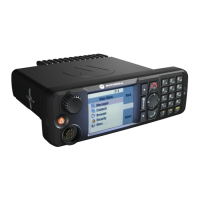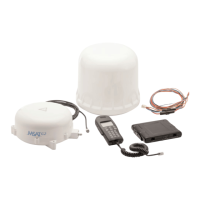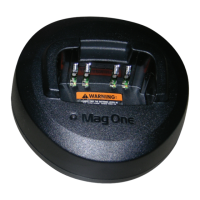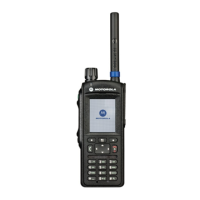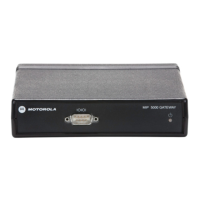68P81083C20-D December 6, 2004
Controller Section Theory of Operation: SB9600 Serial Interface 7-11
When the µP needs to program any of these ICs it brings the chip select line for that IC to a logic 0
and then sends the proper data and clock signals. The amount of data sent to the various ICs are
different, for example the ASFIC can receive up to 21 bytes (168 bits) while the ZIF can receive up to
5 bytes (40 bits). After the data has been sent the chip select line is returned to a logic 1.
The Option board interfaces are different in that the µP can also read data back from devices
connected. The 110W radios currently have circuitry to allow reading data from the Pendulum to
allow reading the pendulum temperature, but this feature has not yet been implemented in software.
Two additional interrupt lines are provided to each of the 2 option boards ASN INT (J0401-22 and
J0408-22) and JABBA INT(J0401-20 J0408-20) are provided to allow an option to signal the µP that
there is data to transfer.
The timing and operation of this interface is specific to the option connected, but generally follows
the pattern 1) an option board device generates the interrupt, 2) main board asserts a chip for that
option board device, 3) the main board µP generates the CLK, and 4) when data transfer is complete
the main board terminates the chip select and CLK activity. Typical Data rate for the SPI BUS is
1 Megabit/sec.
SB9600 Serial Interface
(Refer to schematics on page 10-31 and 10-23 for reference and to “SB9600 BUSY, Simplified Schematic for
Charts 1-10 & 1-11” on page 9-27)
The SB9600 serial interface allows the radio to communicate with external radio options (like a
control head) and Radio Service Software (RSS)/CPS (Customer Program Software). This interface
connects to both the Control Head connector (J0405) and the Accessory connector (J0403) and
comprises BUS+ (J0405-15/J0403-6), BUS- (J0405-4/J0403-18), BUSY (J0405-14/J0403-5) and
RESET (J0405-3/J0403-17). All of these lines are bidirectional, meaning that either the radio or an
option can drive the line.
When the radio needs to send a message (for example to update the Control Head display) it first
checks BUSY IN (U0103-76) to make sure the interface is not currently being used. If this input is a
logic 1 the interface is available and the µP will change BUSY OUT (U0104-G4) to a logic 0. This
drives the BUSY line to a logic 1 through buffer transistor Q0406 informing the radio and all
connected devices that a data transmission is starting.
The radio’s µP then starts sending serial data on SCI TX (U0103-64). This data is buffered by Q0402
and drives the differential bus signals (BUS+/BUS-) through Q0401 and Q0400. The BUS+ line
normally sits at +5 volts because of pull-up resistor R0407. The BUS- line normally sits at 0 Volts
because of pull-down resistor R0412.
While the radio is sending serial data on SCI TX it receives an “echo” of the same data on the SCI
RX (U0103-63) line. The BUS-, BUS+ lines go to U0401 which acts as a comparator. When the
BUS+ voltage is greater than the BUS- voltage the output (at U0401-7) is a logic 1. If it is less, the
output is a logic 0. This is routed through U0105 to µP (U0103). Note that the SCI SELECT input to
U0105-11 is at a logic 1 to allow the routing to the controller on BUS SCI (U0105- 13).
A total of 5 bytes of data are sent for each standard message. After the data is sent the BUSY line is
released to its default state (a logic 0). Other devices are now free to use the interface to send data.
The same method of operation occurs when an option sends data to the radio on this interface. The
data is received through U0401 and U0105 (or R0020/R0021) to the SCI RX input of the µP.
The sender receives back an “echo” of each byte and compares this to what was sent. If the echo
does not agree then the transmission is repeated at a later time.
If excessive transmission errors occur, the µP will reset the interface by setting the RESET OUT
(U0104-B7) line to a logic 0. This drives the RESET line to a logic 1 through buffer transistor Q0408
resetting all SCI devices connected.
